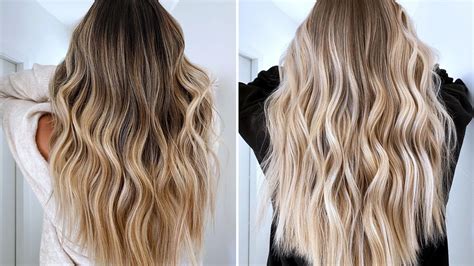Introduction

When choosing the perfect hair color technique, it’s essential to understand the differences between balayage and highlights. These two popular methods offer distinct results that can enhance your overall look. This article provides a comprehensive side-by-side comparison of balayage and highlights, outlining their key characteristics, benefits, and drawbacks.
Balayage vs. Highlights: Key Characteristics
| Feature | Balayage | Highlights |
|---|---|---|
| Application Method | Freehand painting | Foiling or caping |
| Blending | Gradual, seamless | Defined, contrasting |
| Hairline Start | Can start at the roots or mid-lengths | Usually applied to the roots |
| Width of Strands | Thicker, less defined strands | Thinner, more precise strands |
| Maintenance | Less frequent touch-ups (6-12 months) | More frequent touch-ups (3-6 months) |
Benefits of Balayage
Natural Look: Balayage creates a sun-kissed, lived-in effect that mimics natural hair growth.
Versatile: Balayage can be customized to suit any hair color, texture, and style, from subtle highlights to bolder, brighter hues.
Low Maintenance: The gradual blending of balayage means less frequent touch-ups, making it a cost-effective option in the long run.
Drawbacks of Balayage
Skill Dependent: Balayage requires a skilled colorist who can blend the colors seamlessly.
Time Consuming: The freehand application process can take longer than highlights.
Benefits of Highlights
Defined Contrast: Highlights create a more dramatic and contrasting look, adding depth and dimension to the hair.
Precision: The foiling or capping technique ensures precise placement and control over the width and placement of the highlights.
Versatile: Highlights can be adapted to complement various hair colors, styles, and face shapes.
Drawbacks of Highlights
Higher Maintenance: Highlights require more frequent touch-ups to maintain the contrast and prevent fading.
Potential Damage: The use of foils or caps can cause breakage or damage to the hair if not applied correctly.
Which Technique is Right for You?
Choosing between balayage and highlights depends on your individual preferences, hair type, and desired results.
-
If you prefer a natural, sun-kissed look, low maintenance, and less frequent touch-ups: Balayage is a great choice.
-
If you want more defined contrast, precise placement, and a more dramatic effect: Highlights might be a better option.
Cost Comparison
The cost of balayage and highlights can vary depending on the length, thickness, and condition of your hair, as well as the skill level of the colorist.
-
Balayage: Typically costs more than highlights due to the freehand application and blending. Expect to pay $100-$300 or more.
-
Highlights: Can cost less than balayage, but the price may increase if you choose a more intricate or extensive technique. Expect to pay $50-$200 or more.
Tips and Tricks
Choosing the Right Colorist: Research and ask for recommendations to find a reputable and experienced colorist who specializes in balayage or highlights.
Communicate Your Vision: Clearly express your desired results to your colorist, including any reference photos.
Healthy Hair: Ensure your hair is healthy and strong before any color treatment to minimize damage.
Protect Your Color: Use color-protecting products and avoid over-washing to maintain the vibrancy of your balayage or highlights.
Conclusion
Balayage and highlights are two versatile and popular hair color techniques that can transform your look. Understanding the key differences between these methods allows you to make an informed decision that meets your individual hair goals and preferences. Whether you opt for the natural charm of balayage or the defined contrast of highlights, embrace the benefits and minimize the drawbacks to achieve a radiant and healthy hair color.
